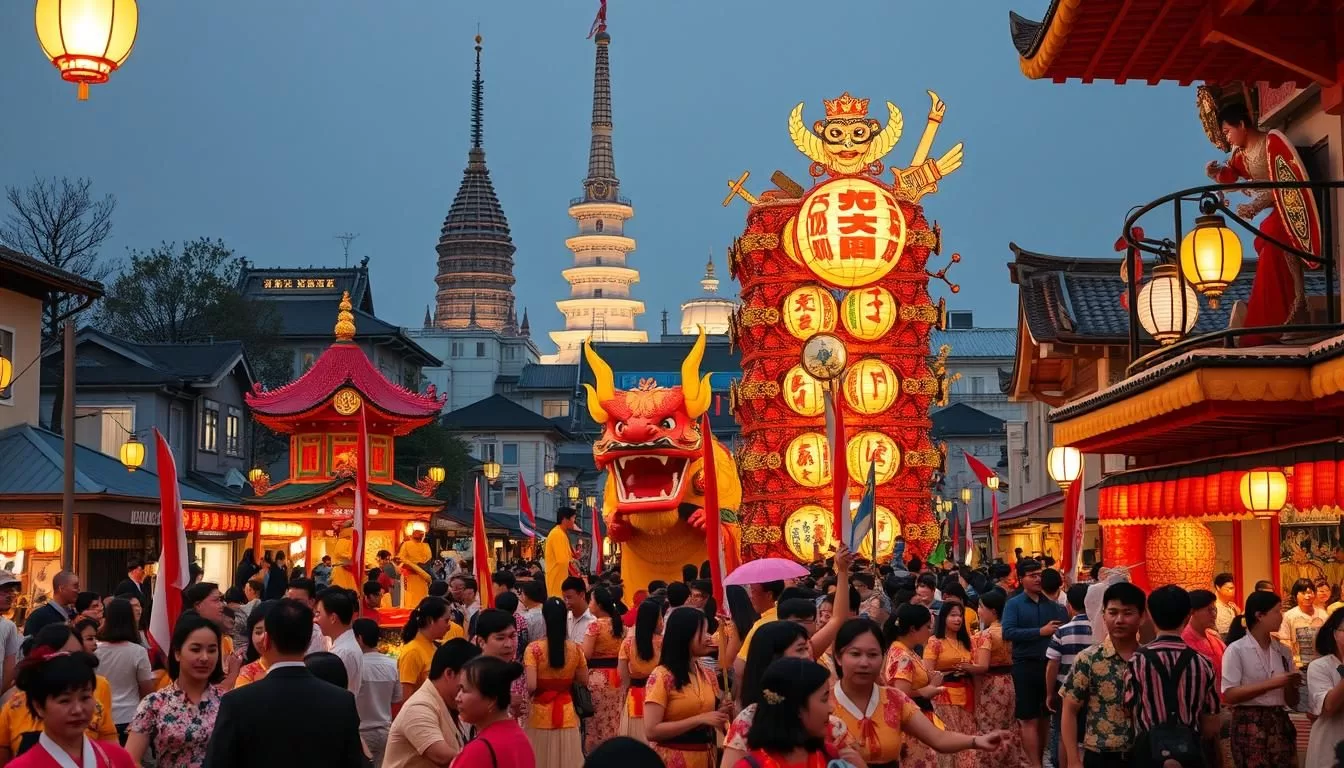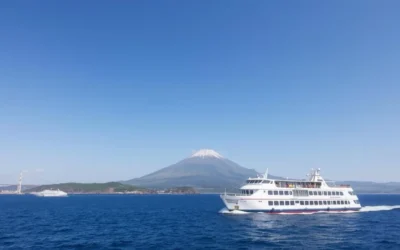✓ Accommodations✓ Flights✓ Rental Cars
When you visit Ibaraki Prefecture, you’re in for a treat. This region neighboring Tokyo is rich in beautiful nature, including rivers and the ocean, and is blessed with an abundance of agricultural products.
Throughout the year, Ibaraki hosts a variety of festivals that showcase Japan’s vibrant culture. You’ll discover unique celebrations that highlight the region’s agricultural bounty, historical significance, and spiritual traditions. From spectacular acrobatic performances to massive portable shrine parades, these events provide unforgettable experiences.
As you plan your visit, this guide will take you through the most impressive festivals in the region, organized by season. You’ll learn about the cultural significance, best viewing spots, and practical tips for enjoying these celebrations like a local, making your trip to Ibaraki Prefecture truly memorable.
Discovering Ibaraki’s Festival Culture
Experience the essence of Ibaraki’s culture through its diverse and captivating festivals. Ibaraki Prefecture is known for its unique blend of traditional and modern celebrations.
The Cultural Significance of Japanese Festivals
Japanese festivals, or “matsuri,” are deeply rooted in the country’s culture and history. They often feature traditional performances, food, and rituals that bring communities together.
What Makes Ibaraki’s Festivals Unique
Ibaraki’s festivals stand out due to their blend of agricultural traditions and cultural heritage. The prefecture’s proximity to Tokyo has helped maintain its authentic cultural practices.
| Unique Aspect | Description |
|---|---|
| Agricultural Traditions | Reflecting the prefecture’s fertile land and abundant harvests. |
| Acrobatic Performances | Spectacular performances not commonly seen in other parts of Japan. |
| Local Elements | Incorporating unique local elements that reflect the region’s history. |
Ibaraki’s festivals showcase a remarkable diversity, from ancient Shinto rituals to modern celebrations highlighting local industries and achievements.
Spring Celebrations in Ibaraki
With the onset of spring, Ibaraki comes alive with festivals that showcase its rich heritage and beauty. This season is perfect for experiencing the unique cultural events and natural flowers that the prefecture has to offer.
Mito Plum Blossom Festival
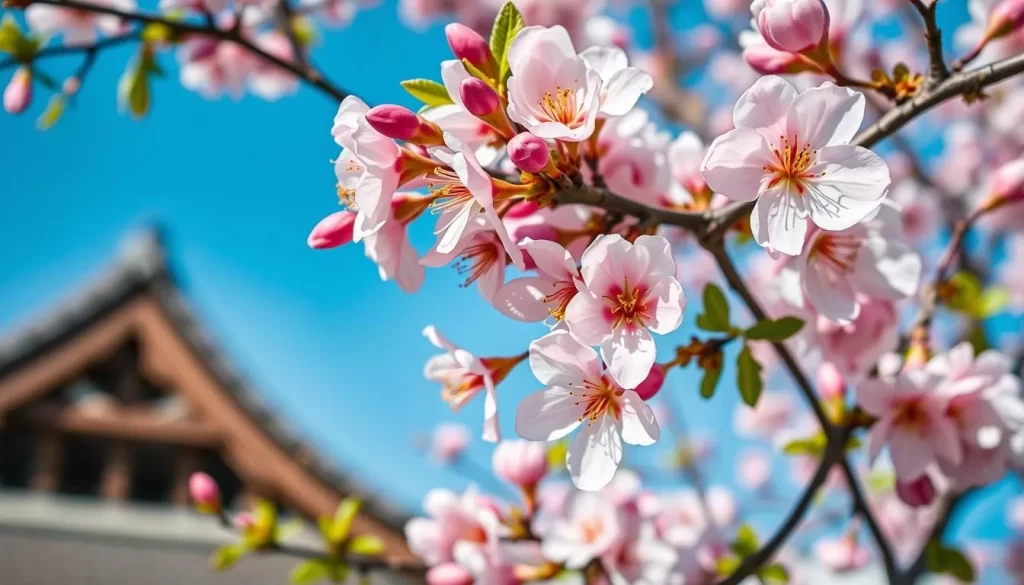
The Mito Plum Blossom Festival is a significant event in Ibaraki, celebrating the blooming of plum blossoms. It’s a place where tradition meets natural beauty, offering a serene atmosphere for visitors.
Spring Flower Festivals at Hitachi Seaside Park
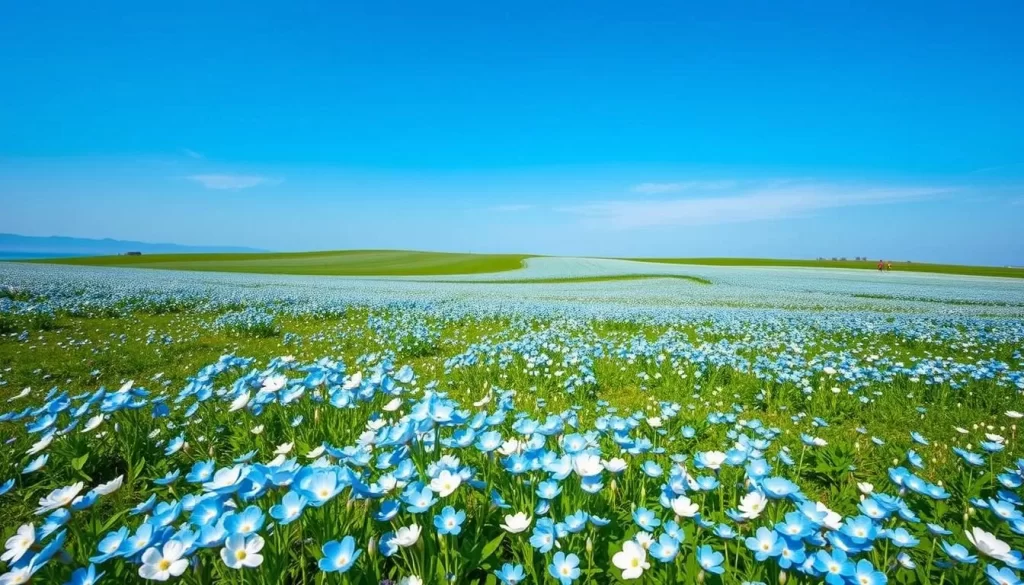
Hitachi Seaside Park is renowned for its stunning spring flower festivals, particularly the nemophila festival, which transforms the park into a breathtaking blue wonderland. Visitors can enjoy various flowers, including tulips and rapeseed blossoms, making it a vibrant event that showcases the beauty of nature.
Early Summer Festivals Worth Visiting
The onset of summer in Ibaraki marks the beginning of a season filled with traditional ceremonies, community events, and local celebrations. These early summer festivals are a great way to experience the prefecture’s vibrant culture.
Traditional Ceremonies and Events
Ibaraki’s early summer festivals feature a range of traditional ceremonies and events that highlight the region’s rich cultural heritage. You can witness traditional dances and performances that have been passed down through generations, showcasing the community’s pride and identity.
Local Community Celebrations
Local communities in Ibaraki come together to organize and participate in festivities, demonstrating the strong bonds between residents. You’ll have the opportunity to experience the warm hospitality of Ibaraki’s people as communities welcome visitors to join in the celebrations.
- Early summer community celebrations in Ibaraki showcase the strong bonds between local residents as entire towns come together.
- These local festivals often feature homemade decorations and locally prepared foods, highlighting regional pride.
- Many small towns in Ibaraki host their own unique summer events, providing an intimate glimpse into rural Japanese life.
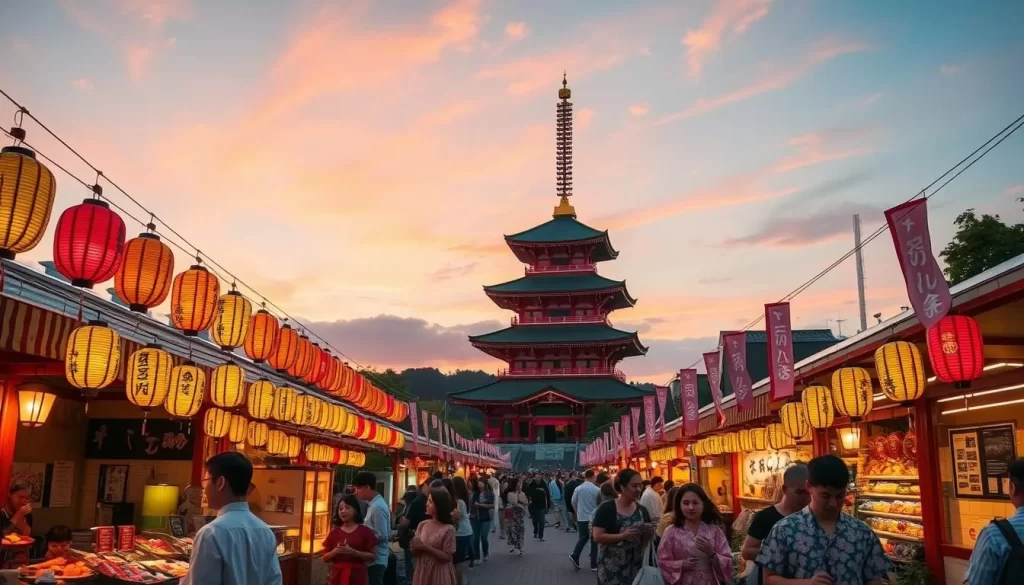
By attending these community-based celebrations, you’ll have the chance to interact with locals in authentic settings, creating memorable cultural exchanges.
Yasaka Shrine Gion Festival and Tsukumai
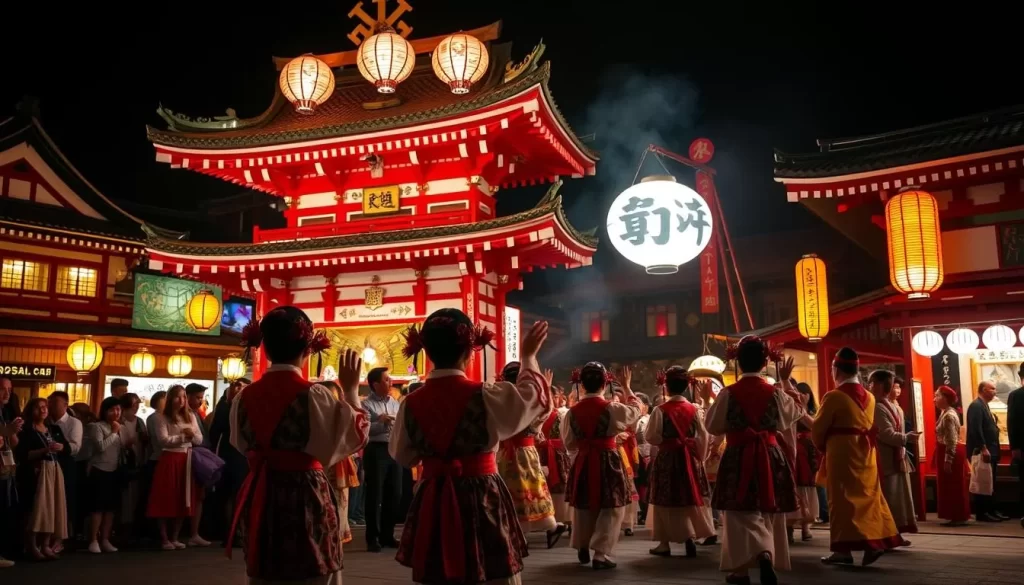
Get ready for an unforgettable night at the Yasaka Shrine Gion festival, featuring the breathtaking Tsukumai performance. This unique event takes place during the summer season in Ryugasaki, Ibaraki Prefecture.
History and Cultural Significance
The Yasaka Shrine Gion Festival has a rich history and cultural significance in the region. It is a traditional event that showcases the local culture and heritage.
The Spectacular Tsukumai Performance
The Tsukumai performance is the highlight of the Yasaka Shrine Gion Festival. Two performers, known as “mai-otoko,” climb a 14-meter tall pole without safety equipment, wearing frog masks and traditional costumes. They perform acrobatic feats, including handstands and shooting arrows, accompanied by traditional flute and drum music. The crowd erupts in cheers as the performers demonstrate their extraordinary skills against the night sky.
- The Tsukumai performance takes place on the final evening of the festival as darkness falls.
- The “mai-otoko” performers climb the towering pole without safety harnesses, wearing distinctive frog masks and traditional costumes.
- The performance features incredible feats of balance and strength, including handstands and acrobatics atop the narrow pole.
- Traditional flute and drum music accompanies the performance, enhancing the dramatic tension.
- This rare spectacle draws large crowds who gather in anticipation of the daring performance.
Shimodate Gion Festival: A Historic Celebration
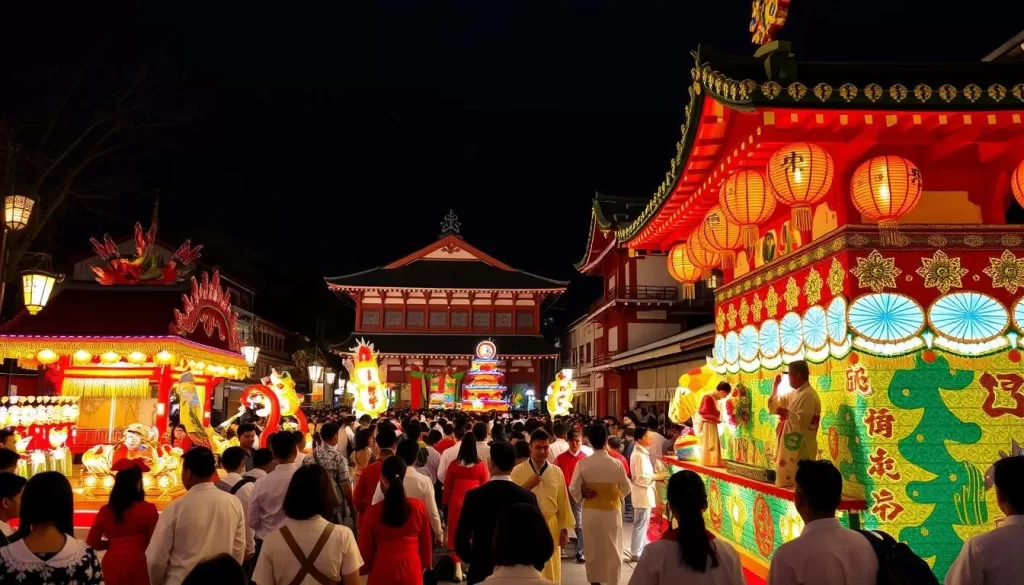
As one of Japan’s most revered festivals, the Shimodate Gion Festival offers a glimpse into the country’s rich cultural past. This historic celebration is known for its vibrant tradition and unique events.
The Impressive Mikoshi Parade
The festival features an impressive mikoshi parade, where participants carry elaborate portable shrines through the streets. This spectacle is a highlight of the event, showcasing the community’s spirit and tradition.
Kawatogyo: The Unique Purification Ceremony
One of the festival’s main attractions is Kawatogyo, a unique purification ceremony where Shinto shrine parishioners carry mikoshi into a nearby river, washing away impurities. This rare tradition creates a spectacular sight and is a significant part of the festival’s cultural heritage.
Mito Komon Festival: Honoring a Historical Hero
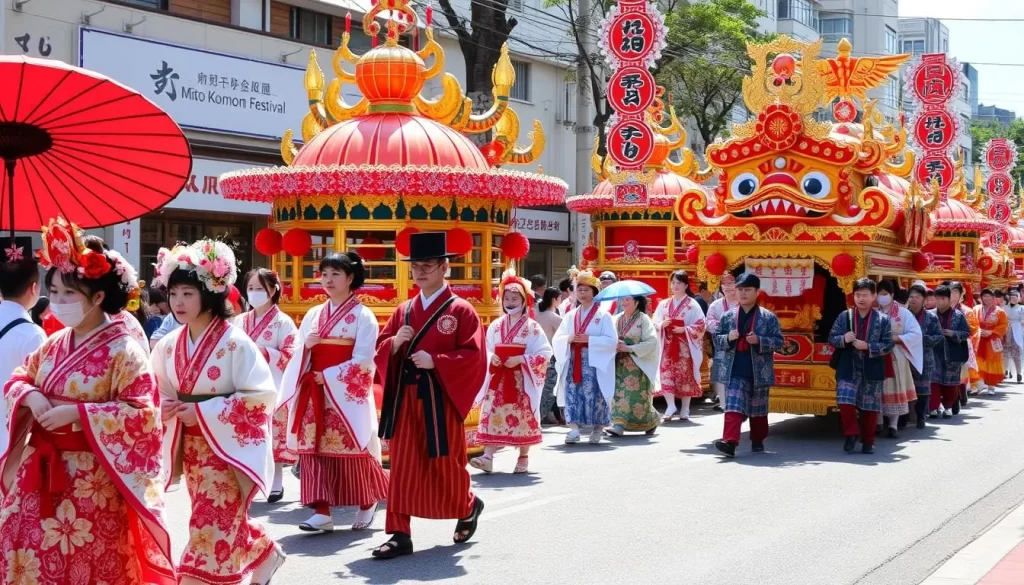
Discover the essence of Ibaraki’s cultural identity at the Mito Komon Festival, a vibrant celebration honoring a historical hero. This festival is a significant cultural event that showcases the region’s rich heritage through various performances and parades.
Street Parades and Performances
The Mito Komon Festival features lively street parades with participants dressed in traditional attire, creating a festive atmosphere. You can enjoy the vibrant displays of Japanese culture, including music and dance performances that highlight the historical significance of the event.
Fireworks Display at Kairakuen Garden
The festival culminates in a breathtaking display of fireworks at Kairakuen Garden, one of Japan’s most celebrated landscape gardens. On a summer night, you can witness a spectacular pyrotechnic show designed by Nomura Hanabi Kogyo, a renowned fireworks company.
- The Mito Komon Festival culminates with a spectacular fireworks display at the historic Kairakuen Garden.
- You can witness a breathtaking pyrotechnic show designed by Nomura Hanabi Kogyo.
- The nighttime event features thousands of colorful explosions illuminating the summer sky.
Ishioka Festival: A Thousand-Year Tradition
With a history spanning over a thousand years, the Ishioka Festival is a must-experience event. It’s a celebration that embodies the rich culture and tradition of Ibaraki Prefecture.
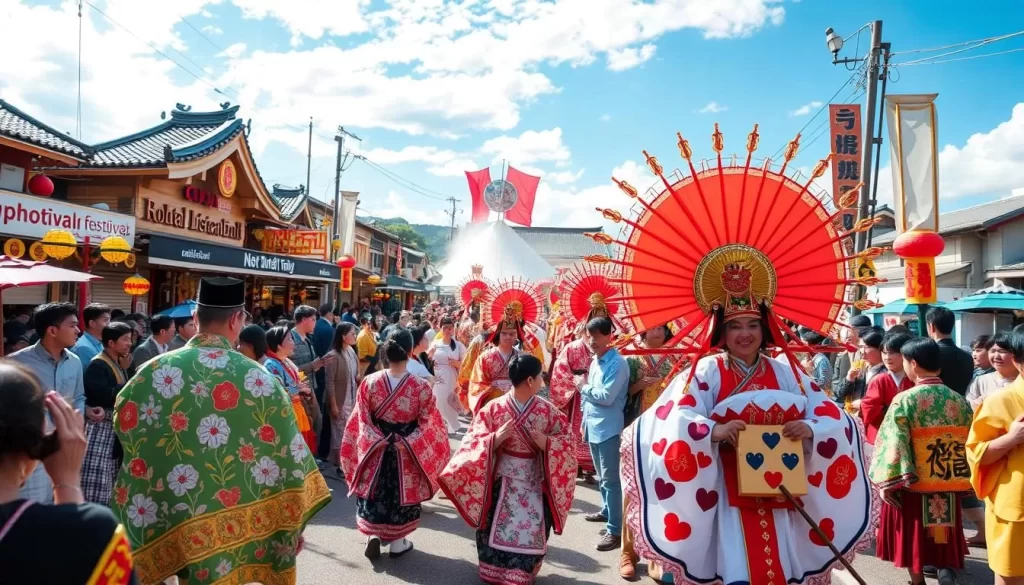
The Ishioka Festival, associated with the Hitachi no Kuni Soshagu shrine, is renowned for its diverse traditional performances. The festival features sumo wrestling matches, sacred Shinto dances called kagura, and the climactic Ishioka Bayashi, or festival music, accompanying the parade of dashi floats.
The Horojishi Lion Dance
The Horojishi Lion Dance is a highlight of the Ishioka Festival, showcasing a dynamic blend of dance and music. This traditional performance is believed to ward off evil spirits and bring good fortune.
Ishioka Bayashi and Traditional Performances
The Ishioka Bayashi, or music, is the soul of the festival, featuring centuries-preserved rhythms and melodies. The festival offers a rare convergence of traditional Japanese performing arts, including kagura dances, sumo wrestling, and musical performances, making it a unique cultural experience.
The Ishioka Festival is a testament to the region’s rich culture and tradition, attracting visitors from afar. Its comprehensive display of traditional Japanese arts, including the Ishioka Bayashi and various performances, underscores its significance as a cultural event.
Tsukuba Festival: Modern Celebrations
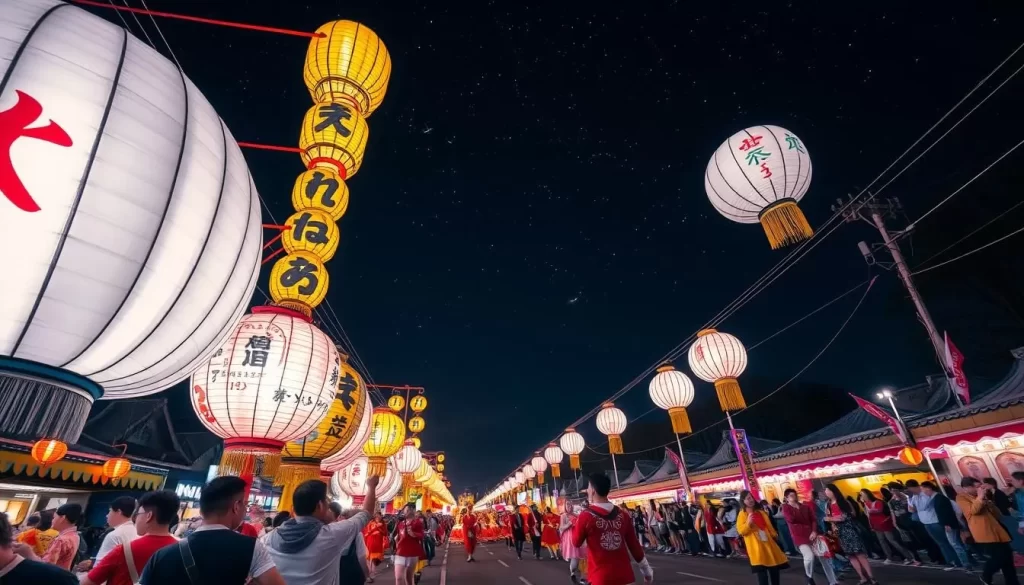
Experience the energy of Tsukuba’s modern festival, a unique blend of traditional and contemporary elements. The Tsukuba Festival is a highlight of the summer season, offering a captivating experience that combines rich cultural heritage with modern sensibilities.
The Tsukuba Manto Mikoshi
The Tsukuba Manto Mikoshi is a portable shrine adorned with lanterns, symbolizing the city’s spiritual and cultural traditions. This magnificent structure is paraded through the streets, accompanied by lively performances that engage the community and visitors alike.
Nebuta Parade and Street Performances
The Nebuta Parade is a breathtaking spectacle featuring enormous, illuminated lanterns in the shapes of warriors, mythological creatures, and animals. As these massive structures are paraded through the streets, they create a spectacular moving light show. The parade is accompanied by street performances, with dancers, musicians, and performers creating an energetic atmosphere throughout the festival grounds.
Autumn Festivals in Ibaraki Prefecture, Japan: Top Festivals to Check Out When Visiting
The autumn festivals in Ibaraki Prefecture offer a unique glimpse into the region’s culture and tradition, featuring a mix of music, dance, and theatrical elements. These festivals are a significant part of the prefecture’s identity and are worth experiencing during your visit.
Harvest Celebrations
Autumn is a time for harvest celebrations in Ibaraki, with many festivals centered around the season’s bounty. The Owara Kaze no Bon Festival is a notable example, combining music, folk tales, and dance to create an elegant experience. Originally, it was created to appease the winds and pray for safety from natural disasters.
| Festival | Location | Features |
|---|---|---|
| Owara Kaze no Bon | Ibaraki Prefecture | Music, Dance, Folk Tales |
| Other Autumn Festivals | Various Locations | Harvest Celebrations, Cultural Performances |
Cultural Performances and Traditions
During autumn, you can witness various performances that are unique to this season. Many festivals include special dance traditions and the use of traditional instruments like taiko drums and shamisen, enhancing the festive atmosphere. These events provide insight into Ibaraki’s rich cultural heritage and its connection to the changing seasons.
Winter Festivities and New Year Celebrations
Winter in Ibaraki is a time for joyous festivities and traditional events. As the year comes to a close, the prefecture is filled with excitement and anticipation for the New Year.
Traditional Winter Events
Although specific winter festivals like those in other parts of Japan, such as the “Namahage” in Akita, are not native to Ibaraki, the prefecture still observes traditional winter events with great fervor. You can experience the unique tradition of Ibaraki’s New Year celebrations.
New Year Customs and Celebrations
Ibaraki’s shrines and temples host special events during the New Year (Shōgatsu). You can participate in Hatsumōde, the first shrine visit of the year, at major shrines like Kashima Shrine. Enjoy traditional lion dances (shishi-mai) and sample local New Year foods like ozōni and osechi ryōri at festival food stalls throughout the prefecture, making for a memorable celebration at a local shrine.
![]()
Food and Culinary Experiences at Ibaraki Festivals
Ibaraki’s festivals are a treat for the taste buds, with numerous food stalls serving local specialties and traditional festival foods. During these events, you can indulge in a variety of delicious food that showcases the prefecture’s culinary delights.
Traditional Festival Foods
The festivals in Ibaraki feature a range of traditional foods that are unique to the area. You can try unique preparations like daigaku-imo (candied sweet potatoes) and imogashi (sweet potato cakes), which are made from the prefecture’s famous sweet potatoes.
Local Specialties to Try
Some of the local specialties you shouldn’t miss include Hitachi beef, a premium Japanese wagyu, often grilled fresh at festival food stalls. The coastal regions of Ibaraki also provide excellent seafood specialties, such as fresh anko (monkfish) and hokki-gai (surf clam) dishes. Sampling these delicacies is a culinary experience you won’t forget.
Music and Performances at Ibaraki Festivals
When attending a festival in Ibaraki, you can expect to be treated to a variety of traditional performances and music that are deeply rooted in the local culture. The region’s festivals are a celebration of its rich tradition and heritage.
Traditional Instruments and Sounds
Ibaraki’s festivals feature a range of traditional Japanese instruments, creating a unique soundscape. The sounds of these instruments are an integral part of the music that accompanies various performances, including sacred Shinto dances called kagura.
Dance and Theatrical Performances
The festivals showcase a variety of dance styles, including kagura, which are sacred Shinto dance-dramas representing some of Japan’s oldest performing arts. You can witness unique regional dance styles that tell stories of local legends and historical events through carefully choreographed movements.
- Kagura performances are a highlight, entertaining the gods with songs and performances.
- Many festival performances incorporate elaborate costumes and masks.
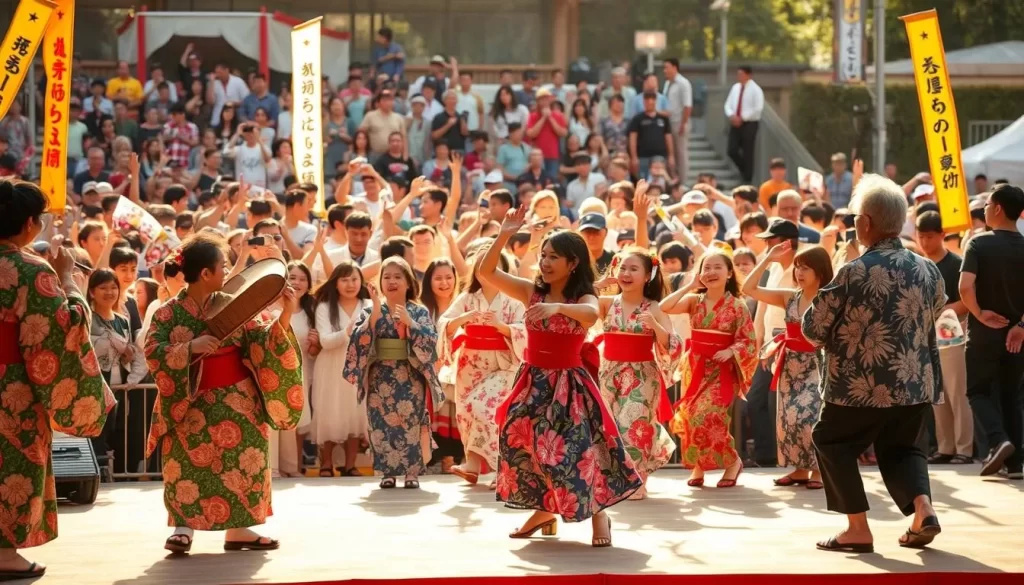
Planning Your Visit to Ibaraki Festivals
With its proximity to Tokyo, Ibaraki Prefecture is easily accessible, but planning your visit to its festivals requires some insider knowledge. Ibaraki Prefecture, which neighbors Tokyo, is home to many festivals, making it an exciting destination for travelers.
Best Times to Visit
The best time to visit Ibaraki’s festivals depends on your preferences. Spring and autumn are popular seasons, with many festivals celebrating the changing seasons. For instance, the Mito Plum Blossom Festival in spring and the harvest celebrations in autumn are not to be missed.
Transportation and Accommodation Tips
When visiting the festival area or city, consider that Ibaraki Prefecture is conveniently accessible from Tokyo by train on the JR Joban Line or highway buses. It’s advisable to book your place to stay well in advance, as hotels in cities like Mito, Tsukuba, and Hitachi fill quickly during major festivals. If accommodations in the festival area are fully booked, consider staying in nearby cities, as Ibaraki’s excellent transportation network makes day trips feasible. You can also use rental cars for flexibility, especially in rural areas, or take advantage of special shuttle buses provided by festival organizers.
Festival Etiquette and Cultural Tips
To fully immerse yourself in Ibaraki’s vibrant festival culture, it’s essential to be aware of the cultural norms and customs. Festivals always bring out the best in people, creating a unique and enriching experience for all participants.
Respectful Participation
When joining in the festival activities, being respectful of the local traditions is key. You’ll find that many locals are happy to explain the significance of certain customs or invite you to participate in the event. By doing so, you’ll not only enhance your experience but also create meaningful connections with the people around you.
Photography and Interaction Guidelines
When capturing the moments of the festival, it’s generally welcomed, but being mindful of any restrictions is crucial, especially during sacred ceremonies. Asking permission before photographing individuals, particularly those in traditional attire, is appreciated and often leads to better photo opportunities. Some activities may have designated photography areas, ensuring that you can capture the best moments without disrupting the festivities.
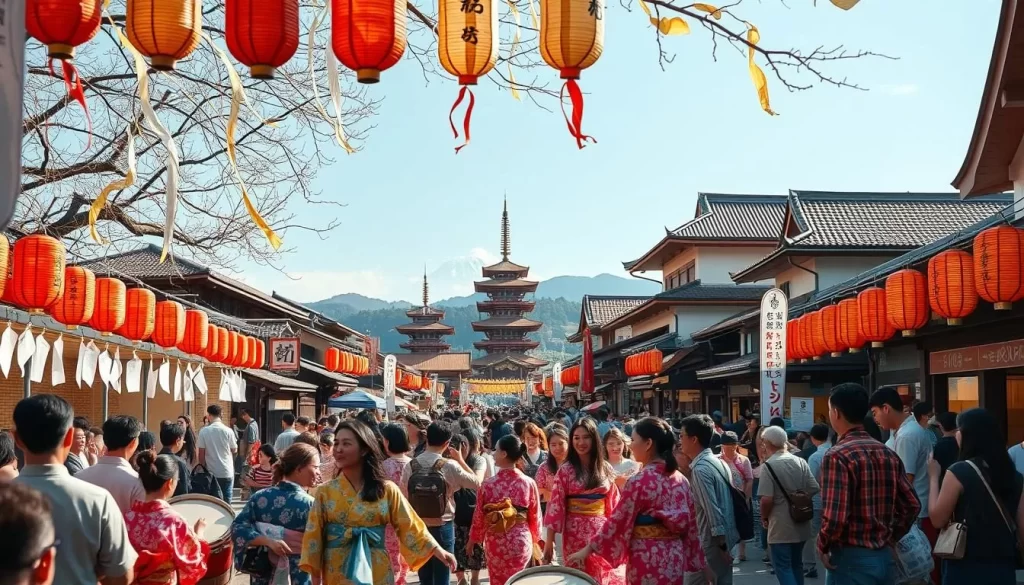
Combining Festival Visits with Other Ibaraki Attractions
To get the most out of your trip to Ibaraki, consider pairing festival visits with explorations of the region’s other attractions. Ibaraki Prefecture offers a rich tapestry of cultural, historical, and natural experiences that complement its vibrant festivals.
Natural Wonders and Parks
Ibaraki is home to numerous natural wonders and parks that are worth visiting. For instance, Kairakuen Garden in Mito is one of Japan’s three most celebrated landscape gardens, offering cultural significance and natural beauty that complements festival experiences. You can also explore other scenic spots that showcase the region’s diverse landscapes.
- Enjoy the scenic beauty of Kairakuen Garden
- Discover the unique flora and fauna of the region
Historical Sites and Cultural Landmarks
The prefecture is also rich in historical sites and cultural landmarks. You can visit Kashima Shrine, one of Japan’s oldest and most important Shinto shrines, which hosts its own festivals while providing insight into traditional religious practices. Additionally, Shunpu Banriso, the former residence of famous artist Kitaoji Rosanjin, showcases traditional Japanese architecture and garden design. Other notable sites include the Mito Tokugawa Museum, which houses artifacts from the powerful Mito Tokugawa clan, and the Science City area of Tsukuba, known for its cutting-edge research facilities.
- Explore the historical significance of Kashima Shrine
- Learn about the cultural heritage at Shunpu Banriso and Mito Tokugawa Museum
Conclusion: Experiencing the Heart of Japan Through Ibaraki’s Festivals
Ibaraki Prefecture’s festivals offer a unique window into Japan’s rich cultural heritage. By participating in these celebrations, you’ll gain a deeper understanding of the local culture and community values.
The diverse festivals in Ibaraki Prefecture showcase the region’s connection to nature and the changing seasons, creating a multisensory experience that includes traditional foods, music, and performances.
By immersing yourself in these events, you’ll create lasting memories and gain insight into aspects of Japan’s culture that are often hidden from visitors, making your journey more meaningful and complete.
The above is subject to change.
Check back often to TRAVEL.COM for the latest travel tips and deals.
